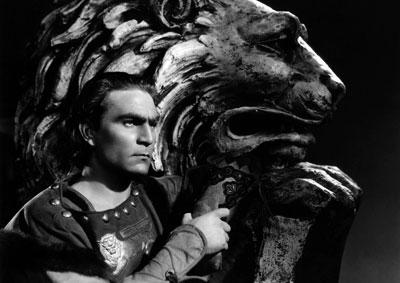Directed by Cecil B. DeMille
Paramount Productions, Inc./A Cecil B. DeMille Production. Screenwriters: Harold Lamb, Dudley Nichols, Waldemar Young. Cinematographer: Victor Milner. Editor: Anne Bauchens. With: Henry Wilcoxon, Loretta Young, Ian Keith, C. Aubrey Smith, Alan Hale.
35mm, b/w, 125 min.
Following the great success of Cleopatra (1934), Cecil B. DeMille lost no time arranging another thundering epic picture to confirm his supremacy at Paramount Pictures, where his career had begun (and which he had helped to found). Following a period of independent production in the late 1920s, and a short residency at Metro-Goldwyn-Mayer, DeMille’s return to Paramount had had been a triumph with The Sign Of The Cross (1932), a baroque display of Roman debauchery and Christian martyrdom. On its face, a story of religious factions clashing for control of Jerusalem might not have seemed salutary to DeMille, who had sustained harsh Jewish protests to King Of Kings (1927), but his faith in the new story (however re-interpreted for the screen) quelled any doubts he may have had, depicting the heroic victory and the character transformation of England’s King Richard “the Lionhearted” (portrayed by Henry Wilcoxon). The scenario posits a violent takeover of Jerusalem by Islamic warrior Saladin, and the pan-European response to this supposed offense against Christianity’s holiest site. Urged to war by his fellow kings and a rabble-rousing “holy man” (C. Aubrey Smith), Richard sees an opportunity to escape a politically expedient marriage to dour Alice, princess of France (DeMille’s daughter, Katherine), but soon finds it necessary to grudgingly take a bride (Loretta Young as Berengaria, princess of Navarre) as a condition of assistance from her father in his campaign. The budding romance which follows this marriage, developing an ever-loftier tone, becomes the film’s tender heart as Richard leads his troops in storming the cities of Acre and Jerusalem in quest of holy relics and victory. Berengeria’s resounding appeal for peace among people of different creeds signals a rapprochement that seems extraordinarily optimistic from a contemporary perspective, but a face-off with surprisingly chivalrous Saladin appears to reflect something of the historical reality of his magnanimity. A sturdy entertainment with amazing set-pieces and memorable flourishes (such as the marriage of Berengeria to an absent Richard’s sword), the expensive picture nonetheless lost money, and moved to the background of discussions of DeMille’s significant work. But it is worthy of reappraisal, and crafted with brio by a master at the height of his powers.
—Shannon Kelley
Restored by UCLA Film & Television Archive and Universal Pictures from 35mm nitrate and acetate materials. Laboratory services by YCM Laboratories, The Stanford Theatre Film Laboratory, BluWave Audio. Special thanks to: Cecilia DeMille Presley, Bob O’Neil.






 Mobile Navigation
Mobile Navigation

